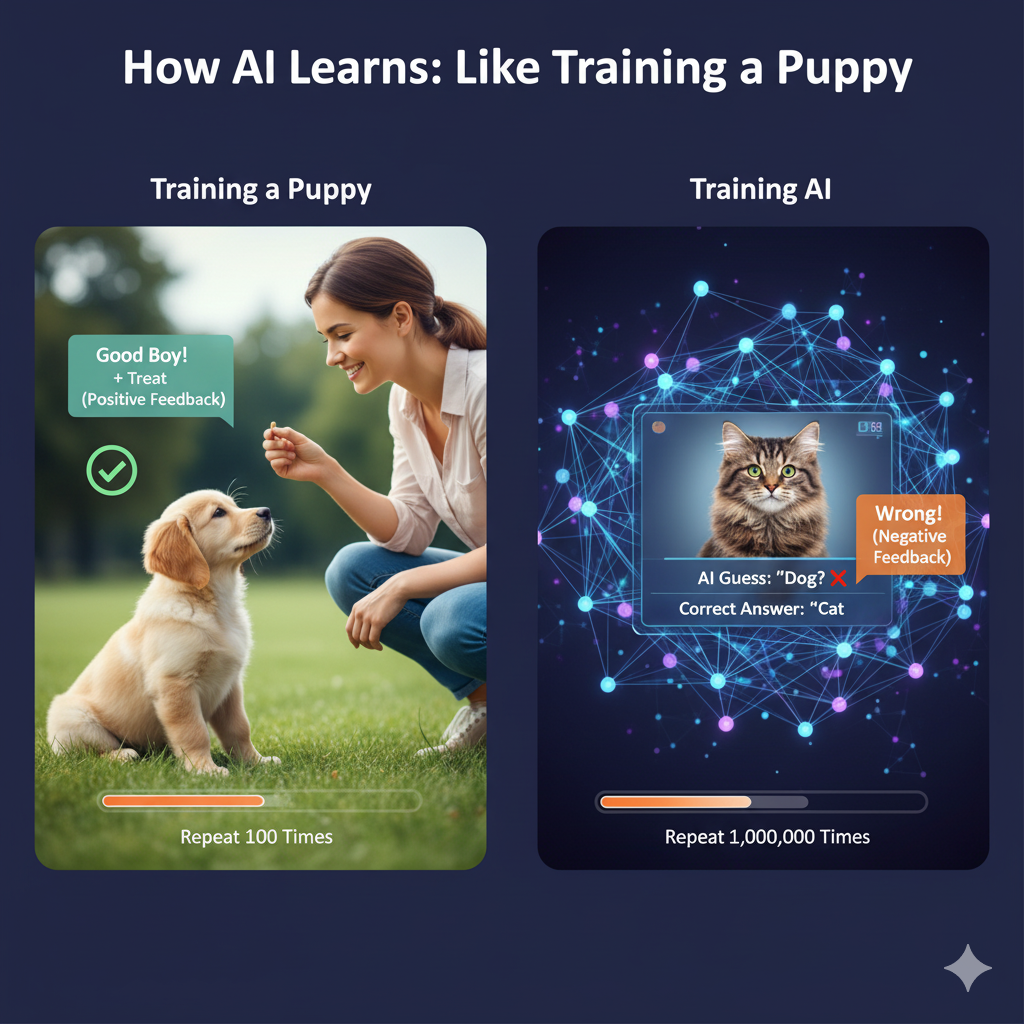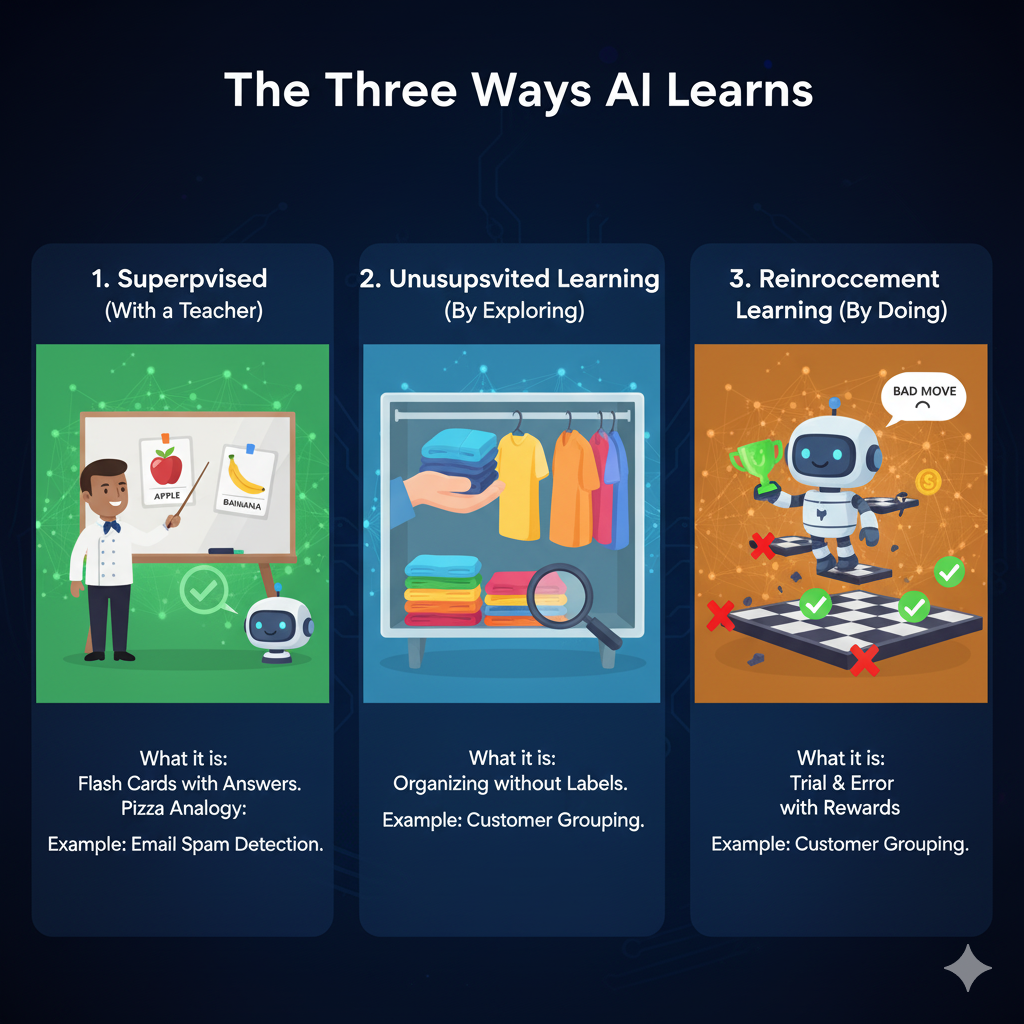How AI Learns - Like Training a Puppy
Updated: October 28, 2025

Training AI is surprisingly similar to training a puppy. Both start knowing nothing, both learn through repetition, and both get better with feedback. The key difference? AI can practice millions of times per hour!
🔗 Building on Chapter 1: Now that you understandwhat AI is, let's explore how it actually learns and improves through experience.
🐕The Puppy Training Analogy
Training a Puppy to Sit
- 1.Show the action: Guide puppy to sitting position
- 2.Give feedback: "Good boy!" + treat (positive) or "No" (negative)
- 3.Repeat: Do this hundreds of times
- 4.Test: Puppy learns to sit on command
- 5.Generalize: Puppy sits even with different people, places
Training AI to Recognize Cats
- 1.Show examples: Feed AI thousands of cat photos
- 2.Give feedback: "Correct!" (when right) or "Wrong!" (when mistaken)
- 3.Repeat: Millions of examples
- 4.Test: AI identifies new cat photos
- 5.Generalize: AI recognizes cats in different poses, lighting
How Learning Actually Works (No Math!)
🧠 Research Conlabel: This learning process is based on how neural networks actually work in machine learning. For the technical foundation, see Deep Learning by Goodfellow et al.(Chapter 6 covers deep feedforward networks) and Google AI's researchon neural network training.
Step 1: Starting Dumb
Step 2: Getting Better
Step 3: Pretty Good
Step 4: Expert Level
The Three Ways AI Learns

1. Supervised Learning (Learning with a Teacher)
Like flash cards with answers on the back
🎓 Academic Foundation: Supervised learning is the foundation of most machine learning systems. Research pioneers like Tom Mitchellat Carnegie Mellon defined the field, and modern implementations are documented in Scikit-learn's supervised learning guide.
Example - Email Spam Detection
Result: AI learns patterns
- • Multiple exclamation marks → Probably spam
- • "Meeting" + time → Probably legitimate
- • "Winner" + "claim" → Probably spam
Real-world uses:
2. Unsupervised Learning (Learning by Exploring)
Like organizing your closet without labels
🔬 Research Background: Unsupervised learning represents a frontier in AI research. Meta AI Researchand DeepMindare advancing self-supervised learning techniques. The foundational work by Geoffrey Hintonon autoencoders transformed this field.
Example - Customer Grouping
No labels, just data
AI created categories without being told what to look for!
Real-world uses:
3. Reinforcement Learning (Learning by Doing)
Like learning a video game through trial and error
🏆 Breakthrough Technology: Reinforcement learning achieved superhuman performance in games. DeepMind's AlphaGodefeated world champion Lee Sedol, and OpenAI's workon reinforcement learning from human feedback powers models like ChatGPT. The mathematical foundation comes from Richard Sutton'sreinforcement learning textbook.
Example - AI Learning Chess
Eventually: AI learns winning strategies without being taught specific moves
Real-world uses:
Why AI Needs So Much Data
Imagine learning a language:
AI is the same:
- • 10 examples: Random guessing
- • 100 examples: Rough patterns
- • 1,000 examples: Basic accuracy
- • 100,000 examples: Good performance
- • 1,000,000+ examples: Expert level
Try This: Train Your Own "AI" (No Computer Needed!)
The Fruit Sorting Game
(Do this with family/friends)
1. Setup
One person is the "AI", others are "trainers"
2. Training Phase
- • Trainers show fruits (or pictures) one at a time
- • AI guesses: "Sweet" or "Sour"
- • Trainers say "Correct" or "Wrong"
- • AI mentally notes patterns
3. After 20 fruits, AI should notice:
- • Citrus fruits (orange, lemon) → Usually sour
- • Berries → Usually sweet
- • Green → Often sour
- • Red/Orange → Often sweet
4. Test Phase
Show new fruits AI hasn't seen
5. Result
AI can now predict sweet/sour with good accuracy!
This is exactly how machine learning works, just with millions of examples instead of 20.
Frequently Asked Questions
How does AI learn in simple terms?
AI learns through pattern recognition and feedback, similar to how you learn. It sees many examples, makes predictions, gets corrected when wrong, and gradually gets better at recognizing patterns. The three main ways AI learns are supervised learning (with labeled examples), unsupervised learning (finding patterns on its own), and reinforcement learning (learning through trial and error with rewards).
What is supervised learning for beginners?
Supervised learning is like learning with flash cards. You show AI examples with correct answers (like emails labeled 'spam' or 'not spam'), and it learns to make similar predictions on new examples. It's the most common type of machine learning and is used for things like email spam filtering, medical diagnosis, and voice recognition.
How much data does AI need to learn?
AI typically needs thousands to millions of examples to learn effectively. With 10 examples, AI just guesses randomly. With 100 examples, it finds basic patterns. With 1,000 examples, it achieves basic accuracy. With 100,000 examples, it performs well, and with 1 million+ examples, it reaches expert level. The exact amount depends on the complexity of the task.
What's the difference between the three types of machine learning?
Supervised learning uses labeled examples (like photos labeled 'cat' or 'dog'), unsupervised learning finds patterns in unlabeled data (like grouping similar customers together), and reinforcement learning learns through trial and error with rewards (like a game AI learning winning strategies). Each type is suited for different kinds of problems and real-world applications.
Can I try machine learning without coding?
Yes! You can simulate machine learning concepts with simple games. For example, the fruit sorting game in this chapter lets you experience how pattern recognition works. You can also try online tools like Google's Teachable Machine, which lets you train simple AI models by showing examples through your webcam, no coding required.
📚 Author & Educational Resources
About This Chapter
Written by the Local AI Master educational team with expertise in making complex machine learning concepts accessible to beginners through relatable analogies.
Last Updated: 2025-10-25
Reading Level: Middle School (Grades 6-8)
Prerequisites: Chapter 1: Understanding AI basics
Target Audience: Middle school students, high school students, beginners interested in AI
Learning Objectives
- •Understand how AI learns through patterns and feedback
- •Differentiate between supervised, unsupervised, and reinforcement learning
- •Recognize real-world examples of each learning type
- •Experience AI learning through hands-on fruit sorting game
- •Understand why AI needs large amounts of data
📖 Authoritative Sources & Further Reading
🎓 Key Takeaways
- ✓AI learns like a puppy - through repetition and feedback
- ✓Three learning types: Supervised (with labels), Unsupervised (finding patterns), Reinforcement (trial and error)
- ✓More data = Better AI - millions of examples lead to expert performance
- ✓Feedback loop is key - AI improves by learning from mistakes
- ✓You can simulate AI learning - the fruit game demonstrates the core concept
Ready to Understand ChatGPT's Architecture?
In Chapter 3, discover how Transformers transformed AI and why ChatGPT is so powerful!
Continue to Chapter 3